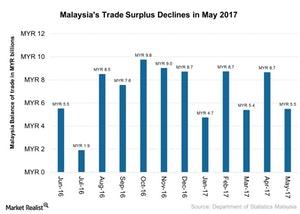Inside Malaysia’s Rising Trade Surplus in May
Malaysia’s (EWM) trade performance in May 2017 appeared to benefit from improved global (ACWI) trade.
July 12 2017, Updated 4:05 p.m. ET

Malaysian trade
Malaysia’s (EWM) trade performance in May 2017 appeared to benefit from improved global (ACWI) trade. Global economic activity is now on an uptrend in 2017 and supporting global trade. The rising trend in exports since last year is helping improve Malaysia’s trade surplus in 2017.
Malaysia’s trade surplus rose to 5.5 billion RM (Malaysian ringgits or MYR) in May 2017, compared with 8.7 billion RM in the previous year. The USD-MYR exchange rate stood at 4.298 on July 10, 2017.
Trade surplus in May 2017
The trade balance in Malaysia (EEM) remained in positive territory in May 2017, though it remained below market estimates of 7.5 billion RM in surplus. Exports continued to rise more than imports in 2017, although at a slower pace than in the previous month.
Exports stood 79.4 billion RM—an increase of 32.5% on a YoY (year-over-year) basis and 7% on a MoM (month-over-month) basis from April 2017. Exports rose for seven consecutive months as of May 2017. Imports stood at 73.9 billion RM, a rise of 30% YoY and 13% MoM from April 2017. Imports also rose for six consecutive months as of May 2017.
Exports increased to China (FXI), the EU (VGK), and Singapore (EWS) in May 2017.
Impact of global markets
Malaysian trade is expected to benefit from improved global growth expectations, but the geopolitical instability around Europe and the Middle East is expected to impact global trade in 2017. The mixed outlook of China’s (FXI) growth is also expected to keep global trade on the edge in 2017.
Meanwhile, the gradual shift of developed economies from accommodative to tighter monetary policies is expected to create a headwind for investments in emerging markets (EEM) like Malaysia.
Now let’s look at the inflationary trend in Malaysia.
